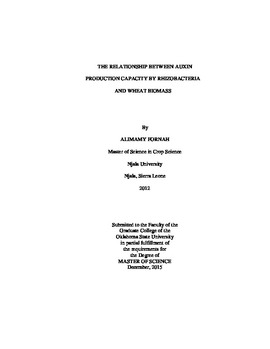| dc.contributor.advisor | Anderson, Michael P. | |
| dc.contributor.author | Fornah, Alimamy | |
| dc.date.accessioned | 2017-02-22T22:12:36Z | |
| dc.date.available | 2017-02-22T22:12:36Z | |
| dc.date.issued | 2015-12-01 | |
| dc.identifier.uri | https://hdl.handle.net/11244/48977 | |
| dc.description.abstract | The plant hormone auxin is known to be involved in growth responses in plants. Bacteria also produce auxin for some unknown reason. In this work we seek to better understand the role of auxin produced by rhizobacteria on plant growth. We determined the relationship between auxin production capacity and wheat biomass for both the rhizosphere and endorhizosphere inhabiting bacteria. A total of 96 wheat plants were grown in two different soil types namely, Teller fine sandy loam and Easpur loam. From 96 plants, 20 were randomly selected from each soil type. Plants were harvested and the shoot biomass determined. A total of 4320 individual bacteria were isolated between the two soil types. Isolates were dilution plated, randomly selected and categorized after 4 days of growth as large (> 2 mm) and small (< 2mm) colonies. Selected isolates were grown for 4 days in 1x TSA, cultures centrifuged and the supernatants transferred to the 96 well plate for the auxin assay based on the Salkowski assay. Auxin concentration in each culture supernatant was measured using a spectrophotometer at 540 nm. In a separate experiment using 576 randomly selected rhizobacteria auxin production capacity and cell growth in culture was measured over a 4 day period at 540 nm and 595 nm spectrophotometrically, respectively. There was a high correlation (R2 = 0.94) between cell growth and auxin production capacity in both large and small growing colonies indicating a strong relationship between bacteria cell growth and auxin production. Examining the correlation between auxin production capacity and biomass productivity from the 20 selected plants was determined by least square regression. The relationship was in most cases negative and non-significant, except for large colony bacteria in the endorhizosphere of the Teller fine sandy loam soils, which was negative and significant (p value <0.0148). Large colonies from both soils produced (33%) significantly higher average auxin concentrations (p value < 0.005) than small colonies. There was no significant difference in auxin production capacity between the two soil types (p value<0.183). The result suggests that auxin production capacity by bacteria is not related to plant growth promotion. | |
| dc.format | application/pdf | |
| dc.language | en_US | |
| dc.rights | Copyright is held by the author who has granted the Oklahoma State University Library the non-exclusive right to share this material in its institutional repository. Contact Digital Library Services at lib-dls@okstate.edu or 405-744-9161 for the permission policy on the use, reproduction or distribution of this material. | |
| dc.title | Relationship Between Auxin Production Capacity by Rhizobacteria and Wheat Biomass | |
| dc.contributor.committeeMember | Habiger, Joshua D | |
| dc.contributor.committeeMember | Deng, Shiping | |
| osu.filename | Fornah_okstate_0664M_14397.pdf | |
| osu.accesstype | Open Access | |
| dc.description.department | Plant & Soil Sciences | |
| dc.type.genre | Thesis | |
| dc.type.material | text | |
